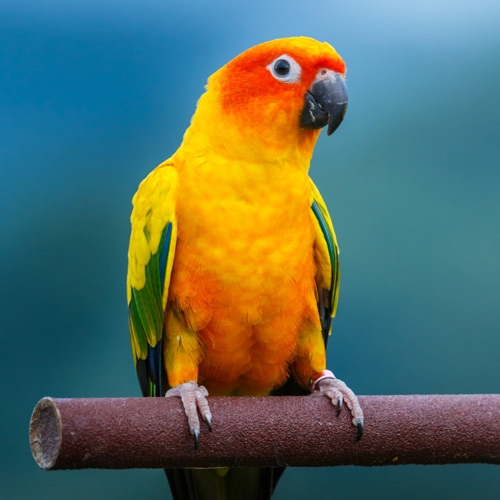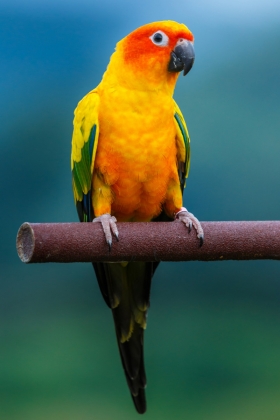
Sun Conure
Aratinga solstitialis
Animal Behavior: Sun conures live in pairs or in small flocks varying from 3 to 15 individuals, although groups of smaller than 5 are most common. Large flocks of 20 to 30 birds can build up where fruiting trees and bushes are abundant. Highly social birds, sun conures will never leave their flock. Their movements may be nomadic or seasonal and based on food availability, although some populations are present year-round. Flocks are surprisingly quiet while feeding but are extremely noisy in flight, usually heard long before they are seen. Sun conures are very smart, curious birds that require mental stimulation and social interaction. Though they can be taught simple tricks and have some talent for talking, they are prone to behavioral problems such as screaming, biting and chewing. They also have an impressive ability to manipulate their feet, bills, and tongues and tend to be more wary than other conure species.
Eating Habits: Little is known about the actual diet of these birds in the wild. The stomach contents of examined birds have indicated that they feed on ripe and half-ripe seeds of various fruits and berries. They have also been known to eat nuts, blossoms, buds, fruit pits, wind-dispersed seeds and insects. Some groups of sun conures have also been known to devour and destroy entire crops near human habituation. Red cactus fruit is also a likely food choice among these birds as well as Malpighia berries and legume pods.
Range: Sun conures are found only in tropical habitats, preferring to live on open savannah or within dry savanna woodland. They are also commonly found in scrublands (usually along the Amazon riverbank) and forested valleys, as well as in coastal and seasonally flooded forests. Preferring an altitude of less than 1200 meters, these birds sometimes live in valleys or near mountain slopes. They tend to inhabit palm groves and anywhere where trees or bushes are fruiting profusely. They may require post-fire habitats and are sensitive to human activity such as cattle grazing. These birds have not been widely studied in the wild because they only reside in largely undeveloped parts of the country that are difficult to access.
Conservation Efforts: The Psittacidae family is considered the most endangered large avian family in the world. Sun conures as a species are also considered endangered due to the rapid reduction in its wild population size over the last three decades. While once believed to be fairly common, it is now believed that the supposed large population numbers may have simply been the result of a few populations occupying large ranges. Trapping for the pet trade has also played a significant part in reducing the species population by removing it from most of its former range. In 1988, this species was first recognized as near threatened. By 2004, it was considered of least concern but is now once again considered endangered and is in need of effective protection as the population continues to decrease.
Animal Facts: Sun conures are considered to be 'the most beautiful of neotropical parrots." Adults are typically 30 cm in length and weigh between 100 and 123 g. The wings measure 146 to 162 mm in length and the bill grows to somewhere between 19 and 25 mm. They have medium-sized bodies and long, pointed tails. In coloration, these birds are bright yellow with red markings on the sides of their head and a red-orange tinge on their forehead, lower abdomen, rump, and lower back. The under tail-coverts are green and yellow with similar coloration on the mantle, lesser and median upper and under wing-coverts. The secondary coverts are green with the outer webs of primary coverts being blue. The primary and secondary feathers are green with the primaries becoming blue near the tips. The upper-side of the tail is olive and tipped with blue while the underside of the tail and the flight feathers are olive-grey. Their irises are dark brown with a naked, white eye ring surrounding both eyes. The bill and legs are both dark in coloration, a shade somewhere between grey and black. Older birds may have more of a flesh tone to their feet.
